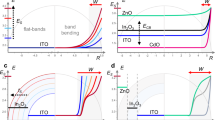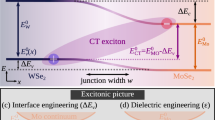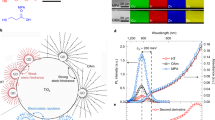Abstract
The potential profile and the energy level offset of core–shell heterostructured nanocrystals (h-NCs) determine the photophysical properties and the charge transport characteristics of h-NC solids. However, limited material choices for heavy metal-free III-V–II-VI h-NCs pose challenges in comprehensive control of the potential profile. Herein, we present an approach to such a control by steering dipole densities at the interface of III-V–II-VI h-NCs. The controllable heterovalency at the interface is responsible for interfacial dipole densities that result in the vacuum-level shift, providing an additional knob for the control of optical and electrical characteristics of h-NCs. The synthesis of h-NCs with atomic precision allows us to correlate interfacial dipole moments with the NCs’ photochemical stability and optoelectronic performance.
This is a preview of subscription content, access via your institution
Access options
Access Nature and 54 other Nature Portfolio journals
Get Nature+, our best-value online-access subscription
$29.99 / 30 days
cancel any time
Subscribe to this journal
Receive 12 print issues and online access
$259.00 per year
only $21.58 per issue
Buy this article
- Purchase on Springer Link
- Instant access to full article PDF
Prices may be subject to local taxes which are calculated during checkout




Similar content being viewed by others
Data availability
The authors declare that all data supporting this work are contained in graphics displayed in the main text or in supplementary information. Numerical data for figures are available in this repository: Jeong et al., Interface polarization in heterovalent core/shell NCs (Materials Cloud Archive 2021.X, 2021); https://doi.org/10.24435/materialscloud:xk-xk. Source data are provided with this paper. Additional information is available from the corresponding authors on request.
Reference
Brus, L. Electronic wave functions in semiconductor clusters: experiment and theory. J. Phys. Chem. 90, 2555–2560 (1986).
Ekimov, A. I., Efros, A. L. & Onushchenko, A. A. Quantum size effect in semiconductor microcrystals. Solid State Commun. 56, 921–924 (1985).
Murray, C. B., Norris, D. J. & Bawendi, M. G. Synthesis and characterization of nearly monodisperse CdE (E = sulfur, selenium, tellurium) semiconductor nanocrystallites. J. Am. Chem. Soc. 115, 8706–8715 (1993).
Pietryga, J. M. et al. Spectroscopic and device aspects of nanocrystal quantum dots. Chem. Rev. 116, 10513–10622 (2016).
Park, Y.-S., Lim, J. & Klimov, V. I. Asymmetrically strained quantum dots with non-fluctuating single-dot emission spectra and subthermal room-temperature linewidths. Nat. Mater. 18, 249–255 (2019).
Colvin, V. L., Schlamp, M. C. & Alivisatos, A. P. Light-emitting diodes made from cadmium selenide nanocrystals and a semiconducting polymer. Nature 370, 354–357 (1994).
Wang, Y. & Herron, N. Photoconductivity of CdS nanocluster-doped polymers. Chem. Phys. Lett. 200, 71–75 (1992).
McDonald, S. A. et al. Solution-processed PbS quantum dot infrared photodetectors and photovoltaics. Nat. Mater. 4, 138–142 (2005).
Klimov, V. I. et al. Optical gain and stimulated emission in nanocrystal quantum dots. Science 290, 314 (2000).
Lim, J., Park, Y.-S. & Klimov, V. I. Optical gain in colloidal quantum dots achieved with direct-current electrical pumping. Nat. Mater. 17, 42–49 (2018).
Meinardi, F. et al. Large-area luminescent solar concentrators based on ‘Stokes-shift-engineered’ nanocrystals in a mass-polymerized PMMA matrix. Nat. Photonics 8, 392–399 (2014).
Meinardi, F. et al. Highly efficient large-area colourless luminescent solar concentrators using heavy-metal-free colloidal quantum dots. Nat. Nanotechnol. 10, 878–885 (2015).
Bruchez, M., Moronne, M., Gin, P., Weiss, S. & Alivisatos, A. P. Semiconductor nanocrystals as fluorescent biological labels. Science 281, 2013–2016 (1998).
Chan, W. C. W. & Nie, S. Quantum dot bioconjugates for ultrasensitive nonisotopic detection. Science 281, 2016 (1998).
Michalet, X. et al. Quantum dots for live cells, in vivo imaging, and diagnostics. Science 307, 538–544 (2005).
Medintz, I. L., Uyeda, H. T., Goldman, E. R. & Mattoussi, H. Quantum dot bioconjugates for imaging, labelling and sensing. Nat. Mater. 4, 435–446 (2005).
Hines, M. A. & Guyot-Sionnest, P. Synthesis and characterization of strongly luminescing ZnS-capped CdSe nanocrystals. J. Phys. Chem. 100, 468–471 (1996).
Kim, S., Fisher, B., Eisler, H.-J. & Bawendi, M. Type-II quantum dots: CdTe/CdSe(core/shell) and CdSe/ZnTe(core/shell) heterostructures. J. Am. Chem. Soc. 125, 11466–11467 (2003).
García-Santamaría, F. et al. Suppressed Auger recombination in “giant” nanocrystals boosts optical gain performance. Nano Lett. 9, 3482–3488 (2009).
Haubold, S., Haase, M., Kornowski, A. & Weller, H. Strongly luminescent InP/ZnS core–shell nanoparticles. ChemPhysChem 2, 331–334 (2001).
Bae, W. K. et al. Controlling the influence of Auger recombination on the performance of quantum-dot light-emitting diodes. Nat. Commun. 4, 2661 (2013).
Yang, Y. et al. High-efficiency light-emitting devices based on quantum dots with tailored nanostructures. Nat. Photonics 9, 259–266 (2015).
Cao, W. et al. Highly stable QLEDs with improved hole injection via quantum dot structure tailoring. Nat. Commun. 9, 2608 (2018).
Lim, J. et al. Highly efficient cadmium-free quantum dot light-emitting diodes enabled by the direct formation of excitons within InP@ZnSeS quantum dots. ACS Nano 7, 9019–9026 (2013).
Hahm, D. et al. Design principle for bright, robust, and color-pure InP/ZnSexS1–x/ZnS heterostructures. Chem. Mater. 31, 3476–3484 (2019).
Won, Y.-H. et al. Highly efficient and stable InP/ZnSe/ZnS quantum dot light-emitting diodes. Nature 575, 634–638 (2019).
Hahm, D. et al. Environmentally benign nanocrystals: challenges and future directions. J. Inf. Disp. 20, 61–72 (2019).
Reiss, P., Carrière, M., Lincheneau, C., Vaure, L. & Tamang, S. Synthesis of semiconductor nanocrystals, focusing on nontoxic and earth-abundant materials. Chem. Rev. 116, 10731–10819 (2016).
Kley, A. & Neugebauer, J. Atomic and electronic structure of the GaAs/ZnSe(001) interface. Phys. Rev. B. 50, 8616–8628 (1994).
Tung, R. T. & Kronik, L. Charge density and band offsets at heterovalent semiconductor interfaces. Adv. Theory Simul. 1, 1700001 (2018).
Zehner, R. W., Parsons, B. F., Hsung, R. P. & Sita, L. R. Tuning the work function of gold with self-assembled monolayers derived from X−[C6H4−C⋮C−]nC6H4−SH (n = 0, 1, 2; X = H, F, CH3, CF3, and OCH3). Langmuir 15, 1121–1127 (1999).
Rusishvili, M., Wippermann, S., Talapin, D. V. & Galli, G. Stoichiometry of the core determines the electronic structure of core–shell III–V/II–VI nanoparticles. Chem. Mater. 32, 9798–9804 (2020).
Kirkwood, N. et al. Finding and fixing traps in II–VI and III–V colloidal quantum dots: the importance of Z-type ligand passivation. J. Am. Chem. Soc. 140, 15712–15723 (2018).
Friedfeld, M. R. et al. Effects of Zn2+ and Ga3+ doping on the quantum yield of cluster-derived InP quantum dots. J. Chem. Phys. 151, 194702 (2019).
Rinehart, J. D., Schimpf, A. M., Weaver, A. L., Cohn, A. W. & Gamelin, D. R. Photochemical electronic doping of colloidal CdSe nanocrystals. J. Am. Chem. Soc. 135, 18782–18785 (2013).
Carroll, G. M., Tsui, E. Y., Brozek, C. K. & Gamelin, D. R. Spectroelectrochemical measurement of surface electrostatic contributions to colloidal CdSe nanocrystal redox potentials. Chem. Mater. 28, 7912–7918 (2016).
Soreni-Harari, M. et al. Tuning energetic levels in nanocrystal quantum dots through surface manipulations. Nano Lett. 8, 678–684 (2008).
Yaacobi-Gross, N. et al. Molecular control of quantum-dot internal electric field and its application to CdSe-based solar cells. Nat. Mater. 10, 974–979 (2011).
Brown, P. R. et al. Energy level modification in lead sulfide quantum dot thin films through ligand exchange. ACS Nano 8, 5863–5872 (2014).
Chuang, C.-H. M., Brown, P. R., Bulović, V. & Bawendi, M. G. Improved performance and stability in quantum dot solar cells through band alignment engineering. Nat. Mater. 13, 796–801 (2014).
Kroupa, D. M. et al. Tuning colloidal quantum dot band edge positions through solution-phase surface chemistry modification. Nat. Commun. 8, 15257 (2017).
Richter, A. F. et al. Fast electron and slow hole relaxation in InP-based colloidal quantum dots. ACS Nano 13, 14408–14415 (2019).
Cho, E., Jang, H., Lee, J. & Jang, E. Modeling on the size dependent properties of InP quantum dots: a hybrid functional study. Nanotechnology 24, 215201 (2013).
Acknowledgements
We thank S.M. Park and S. Jeong for the synthesis and characterization of InAs NCs. This was supported by the National Research Foundation of Korea (NRF) grant funded by the Ministry of Science, ICT, and Future Planning (nos. 2020R1A2C2011478, 2021M3H4A3A01062964, 2020M3D1A2101319 and 2021M3H4A1A01004332), and Electronics and Telecommunications Research Institute (ETRI) grant funded by the Korean government (no. 20ZB1200, Development of ICT Materials, Components and Equipment Technologies). This research was also supported by Samsung Display.
Author information
Authors and Affiliations
Contributions
B.G.J., J.H.C., D.H., S.R., D.C.L., K.P., E.H. and W.K.B. conceived the original idea and designed the experiments. B.G.J., J.H.C., D.H., D.S. and J.W.P. conducted synthesis and characterization of NCs and analysed the experimental data. J.H.C., Y.K., K.P. and E.H. carried out the computational calculation. S.R., S.L., M.P. and C.L. fabricated all devices and analysed the data. All authors contributed to the preparation of the paper.
Corresponding authors
Ethics declarations
Competing interests
The authors declare no competing interests.
Additional information
Peer review information Nature Materials thanks the anonymous reviewers for their contribution to the peer review of this work.
Publisher’s note Springer Nature remains neutral with regard to jurisdictional claims in published maps and institutional affiliations.
Supplementary information
Supplementary Information
Supplementary Notes 1–8, Figs. 1–23 and Tables 1–7.
Source data
Source Data Fig. 1
Numerical source data for Fig. 1b.
Source Data Fig. 2
Numerical source data for Fig. 2a,c–e.
Source Data Fig. 3
Numerical source data for Fig. 3b,c.
Source Data Fig. 4
Numerical source data for Fig. 4a,b,e.
Rights and permissions
About this article
Cite this article
Jeong, B.G., Chang, J.H., Hahm, D. et al. Interface polarization in heterovalent core–shell nanocrystals. Nat. Mater. 21, 246–252 (2022). https://doi.org/10.1038/s41563-021-01119-8
Received:
Accepted:
Published:
Issue Date:
DOI: https://doi.org/10.1038/s41563-021-01119-8
This article is cited by
-
Recent Developments in Quantum Dot Light-Emitting Diodes for Skin-Attachable Electronics
Korean Journal of Chemical Engineering (2024)
-
InP colloidal quantum dots for visible and near-infrared photonics
Nature Reviews Materials (2023)
-
Probing the atomically diffuse interfaces in Pd@Pt core-shell nanoparticles in three dimensions
Nature Communications (2023)
-
Heteroepitaxial chemistry of zinc chalcogenides on InP nanocrystals for defect-free interfaces with atomic uniformity
Nature Communications (2023)
-
Rapid detections of food pathogens using metal, semiconducting nanoparticles, and their hybrids: a review
Emergent Materials (2023)



